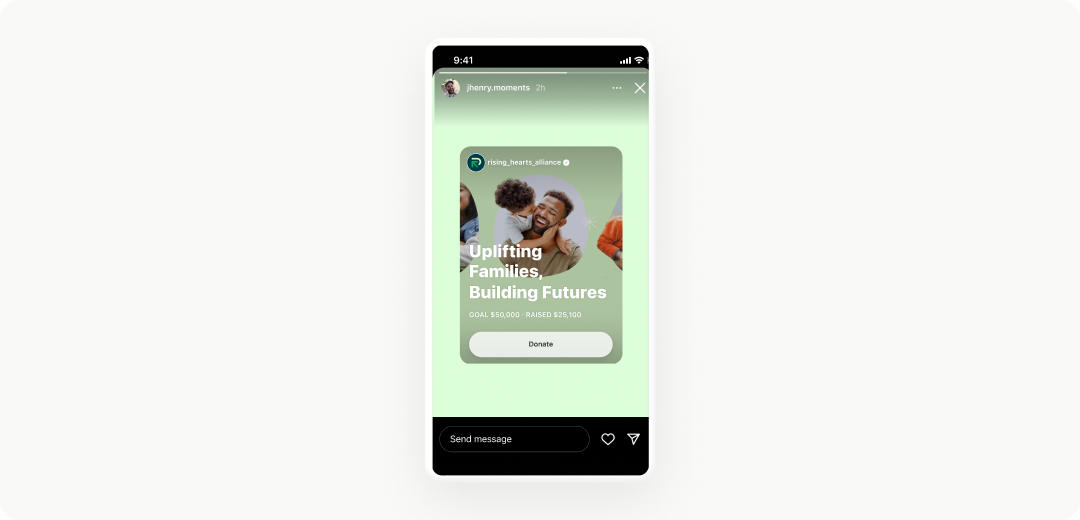Social media fundraising tactics to mobilize your supporters

In today’s digital age, storytelling has become a fundamental part of how people perceive and support causes. A powerful story humanizes your nonprofit organization’s mission, making it more relatable and engaging for current and potential supporters.
However, storytelling’s real impact lies in how far it can spread. The more your supporters share, the greater its reach—and, in turn, its potential to inspire action across social platforms and communities.
With over 200 million users and $40 billion raised, GoFundMe’s fundraising platform now offers new peer-to-peer fundraising and social sharing capabilities that empower supporters to amplify your cause like never before. Let’s explore how your nonprofit can leverage these tools and a strategic social media fundraising approach to elevate your campaigns and reach your fundraising goals.
Why storytelling is central to nonprofit fundraising
The emotional connections forged through storytelling are at the heart of successful nonprofit fundraising. Personal stories illuminate your mission, offering a window into the lives of real people impacted by your cause. This human element creates empathy, motivating potential donors to take action and support your efforts.
For example, reading a powerful testimonial or impact story about a family your nonprofit helped can inspire a donor to give. When you share such stories through social media posts, Instagram stories, or LinkedIn updates, you reach potential donors beyond your immediate network, helping you optimize your outreach.
Beyond making your cause relatable, storytelling is key to long-term engagement. A compelling narrative keeps supporters invested, creating lasting relationships that extend beyond a single donation. Whether it’s a detailed account of how funds achieved a goal or a beneficiary’s story, these narratives resonate with donors, keeping them connected to your fundraising campaign and larger mission.
Expanding your nonprofit’s story through sharing
Storytelling becomes even more impactful when your supporters share it with others. Cross-platform promotion then helps stories spread organically, reaching new audiences in ways a nonprofit’s marketing efforts may not.
When you empower supporters with the tools and encouragement to share your story with their personal networks, it fosters a sense of ownership and deeper engagement with your cause. Plus, our research shows that, on average, every time a supporter shares a fundraiser on GoFundMe, they raise an additional $100.
In the modern fundraising landscape, social media platforms—like Facebook fundraising, Instagram, TikTok, and LinkedIn—play critical roles in this organic spread. Supporters can quickly create social media posts, share campaigns, comment, or host livestreams to broaden the reach of your nonprofit’s story and inspire others to get involved.
The Rival IQ 2025 Social Media Industry Benchmarks Report highlights that nonprofits leveraging social media platforms effectively see significantly higher engagement rates, demonstrating the power of social media marketing for spreading compelling stories and driving donations.
GoFundMe Pro: Enhancing your story with the right fundraising tools
Social sharing integration
GoFundMe Pro’s Meta social sharing integration is a great way for nonprofits to leverage storytelling through social media. This tool empowers donors and supporters to share an organization’s campaigns directly on Instagram or Facebook, amplifying their visibility and reach to target audiences.
With a few clicks, supporters can post their contributions or fundraising pages on their personal social media accounts, instantly turning their networks into advocates for your cause. As more people share these posts—whether via hashtags, calls to action, or video content—your nonprofit’s story continues to ripple outward to reach new audiences.
By equipping supporters with easy-to-use fundraising tools and donation page links, you transform them into powerful ambassadors for your mission and the nonprofit sector.
This integration not only boosts visibility but also reinforces the power of storytelling—each post, share, or comment becomes part of your nonprofit’s larger narrative, helping it grow with every interaction. Plus, nonprofit organizations can access invaluable data on supporter engagement through this integration, helping you optimize your fundraising strategy.
Campaign Studio and livestreaming
Effective storytelling lies in the ability to engage donors throughout the entire fundraising process. GoFundMe Pro’s Campaign Studio offers several features to help nonprofits create a dynamic, real-time narrative around their campaigns and tools to rally their communities around their efforts.
For example, progress bars and live activity feeds show donors the impact of their support as it happens, giving them a sense of pride and accomplishment as they see the needle move closer to the goal. These real-time updates fuel momentum, particularly during live fundraising events or crowdfunding campaigns.
Personalized emails, thank-you pages, and social media messaging also contribute to the storytelling loop. When a donor receives a heartfelt message with a call to action, it reinforces their connection to your cause and encourages them to keep sharing your story with their network. These features help transform a one-time donation into a continuous engagement experience, building loyalty and long-term support.
Plus, your nonprofit can now use GoFundMe’s livestreaming tools during virtual events—hosting educational sessions, behind-the-scenes tours, or charity events that engage audiences in real time. That kind of interaction helps you build trust and a sense of partnership, drawing new donors and boosting fundraising ideas into action.
The future of nonprofit storytelling: How technology plays a role
Imagine if every one of your supporters shared your cause on their social channels. As technology continues to evolve, so too must nonprofit storytelling and fundraising strategies.
Today, it’s critical to meet donors where they are: online and across multiple social media platforms. Nonprofits that leverage technology to expand their reach, build connections, and share their stories will be better equipped to thrive in a competitive fundraising landscape.
GoFundMe’s suite of fundraising tools—including peer-to-peer fundraising capabilities, social media fundraising integrations, and real-time campaign features—gives nonprofits the power to adapt and stay ahead of the curve.
Partnering with influencers and leveraging hashtags can further expand your nonprofit’s social media strategy, driving more traffic to your donation page and fundraising pages. Combining these tactics with in-person fundraising events and traditional outreach rounds out a comprehensive marketing strategy to amplify your impact and expand your reach.
By integrating technology into your storytelling, you can create a narrative that resonates with supporters and inspires action in meaningful, cost-effective ways. Whether through livestreams, short-form videos on TikTok, Instagram stories, or LinkedIn outreach, social media fundraising campaigns tailored to your target audience will help you to scale your reach.
Join the GoFundMe community of over 200 million for access to the right tools to thrive in today’s competitive fundraising landscape, opening the door for your nonprofit to raise awareness, attract new donors, and meet your fundraising goals.
Copy editor: Ayanna Julien

New nonprofit social sharing tools with Meta


